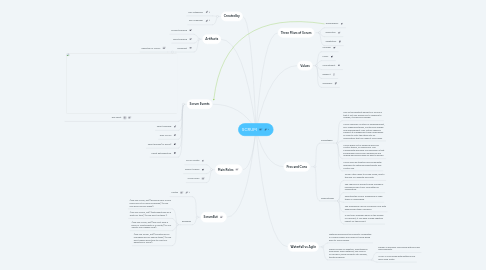
1. Artifacts
1.1. Product Backlog
1.2. Sprint Backlog
1.3. Increment
1.3.1. Definition of "Done"
2. Scrum Events
2.1. The Sprint
2.2. Sprint Planning
2.3. Daily Scrum
2.4. Sprint Review (or Demo)
2.5. Sprint Retrospective
3. Created by
3.1. Jeff Sutherland
3.2. Ken Schwaber
4. Main Roles
4.1. Scrum Master
4.2. Product Owner
4.3. Scrum Team
5. ScrumBut
5.1. Syntax
5.2. Examples
5.2.1. "(We use Scrum, but) (having a Daily Scrum every day is too much overhead,) (so we only have one per week.)"
5.2.2. "(We use Scrum, but) (Retrospectives are a waste of time,) (so we don't do them.)"
5.2.3. "(We use Scrum, but) (we can't build a piece of functionality in a month,) (so our Sprints are 6 weeks long.)"
5.2.4. "(We use Scrum, but) (sometimes our managers give us special tasks,) (so we don't always have time to meet our definition of done.)"
6. Three Pilars of Scrum
6.1. Transparency
6.2. Inspection
6.3. Adaptation
7. Values
7.1. Courage
7.2. Focus
7.3. Commitment
7.4. Respect
7.5. Openness
8. Pros and Cons
8.1. Advantages
8.1.1. One of the greatest benefits of Scrum is that it not only allows you to respond to change, it embraces change.
8.1.2. Scrum requires a culture of empowerment, self-organising teams, continuous change and improvement. This culture requires support at management-level downwards in order to instil the ethos into an organisation that can make it more Agile.
8.1.3. Scrum grew out of empirical process control theory, or empiricism. The fundamental principle of Empiricism is that knowledge comes from experience and making decisions based on what is known.
8.1.4. Scrum uses an iterative and incremental approach to optimize predictability and control risk.
8.2. Disavantages
8.2.1. Scrum often leads to scope creep, due to the lack of a definite end-date.
8.2.2. The chances of project failure are high if individuals aren't very committed or cooperative.
8.2.3. Adopting the Scrum framework in large teams is challenging.
8.2.4. The framework can be successful only with experienced team members.
8.2.5. If any team member leaves in the middle of a project, it can have a huge negative impact on the project.
9. Waterfall vs Agile
9.1. Waterfall works best for projects completed in a linear fashion and does not allow going back to a prior phase.
9.2. Agile focuses on adaptive, simultaneous workflows. Agile methods, like SCRUM or KANBAN, break projects into smaller, iterative periods.
9.2.1. Kanban is primarily concerned with process improvements.
9.2.2. Scrum is concerned with getting more work done faster.
